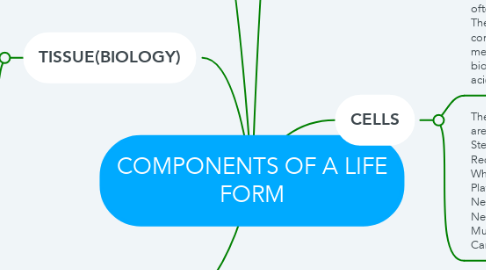COMPONENTS OF A LIFE FORM
by john cancio

1. ORGANISM
1.1. a whole with interdependent parts, likened to a living being.
1.2. Organisms are classified by taxonomy into specified groups such as the multicellular animals, plants, and fungi; or unicellular microorganisms such as a protists, bacteria, and archaea.[1] All types of organisms are capable of reproduction, growth and development, maintenance, and some degree of response to stimuli. Humans are multicellular animals composed of many trillions of cells which differentiate during development into specialized tissues and organs.
2. TISSUE(BIOLOGY)
2.1. In biology, tissue is a cellular organizational level between cells and a complete organ. A tissue is an ensemble of similar cells and their extracellular matrix from the same origin that together carry out a specific function. Organs are then formed by the functional grouping together of multiple tissues.
3. ELEMENTS
3.1. Almost 99% of the mass of the human body is made up of six elements: oxygen, carbon, hydrogen, nitrogen, calcium, and phosphorus. Only about 0.85% is composed of another five elements: potassium, sulfur, sodium, chlorine, and magnesium. All 11 are necessary for life. The remaining elements are trace elements, of which more than a dozen are thought on the basis of good evidence to be necessary for life. All of the mass of the trace elements put together (less than 10 grams for a human body) do not add up to the body mass of magnesium, the least common of the 11 non-trace elements.
4. DNA
4.1. DNA, or deoxyribonucleic acid, is the hereditary material in humans and almost all other organisms. Nearly every cell in a person's body has the same DNA.
4.2. The chemical DNA was first discovered in 1869, but its role in genetic inheritance was not demonstrated until 1943. In 1953 James Watson and Francis Crick, aided by the work of biophysicists Rosalind Franklin and Maurice Wilkins, determined that the structure of DNA is a double-helix polymer, a spiral consisting of two DNA strands wound around each other. The breakthrough led to significant advances in scientists’ understanding of DNA replication and hereditary control of cellular activities.
5. CELLS
5.1. A cell is the smallest unit of life. Cells are often called the "building blocks of life". The study of cells is called cell biology. Cells consist of cytoplasm enclosed within a membrane, which contains many biomolecules such as proteins and nucleic acids.
5.2. The main types of cells in the human body are listed below: Stem cells. Red blood cells (erythrocytes) White blood cells (leukocytes) Platelets. Nerve cells (neurons) Neuroglial cells. Muscle cells (myocytes) Cartillage cells (chondrocytes)


